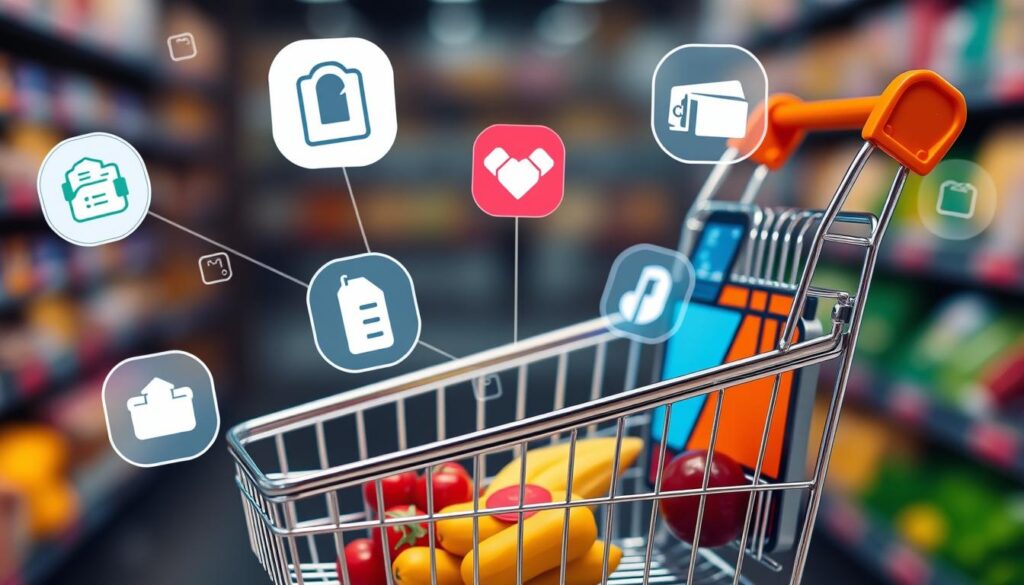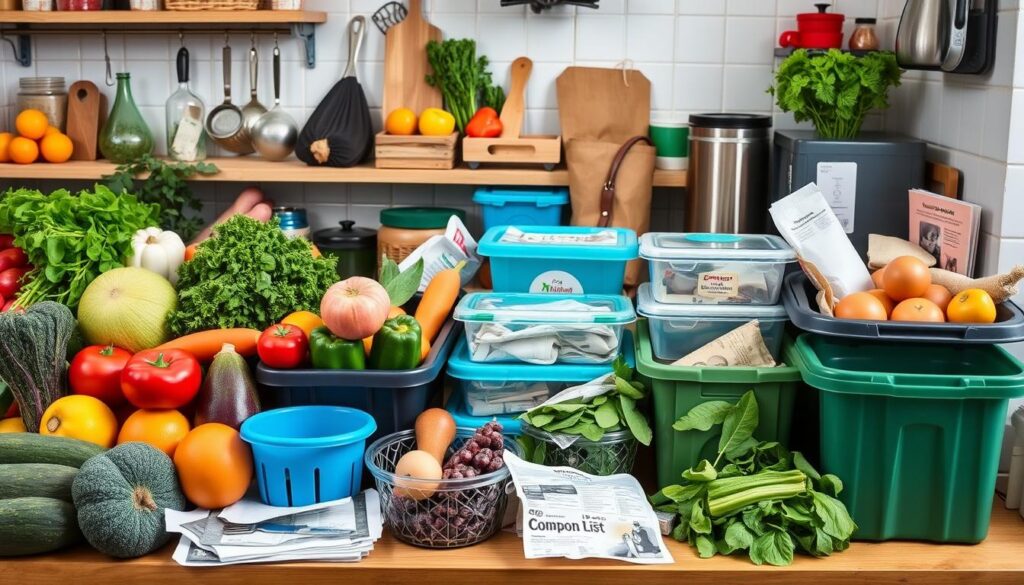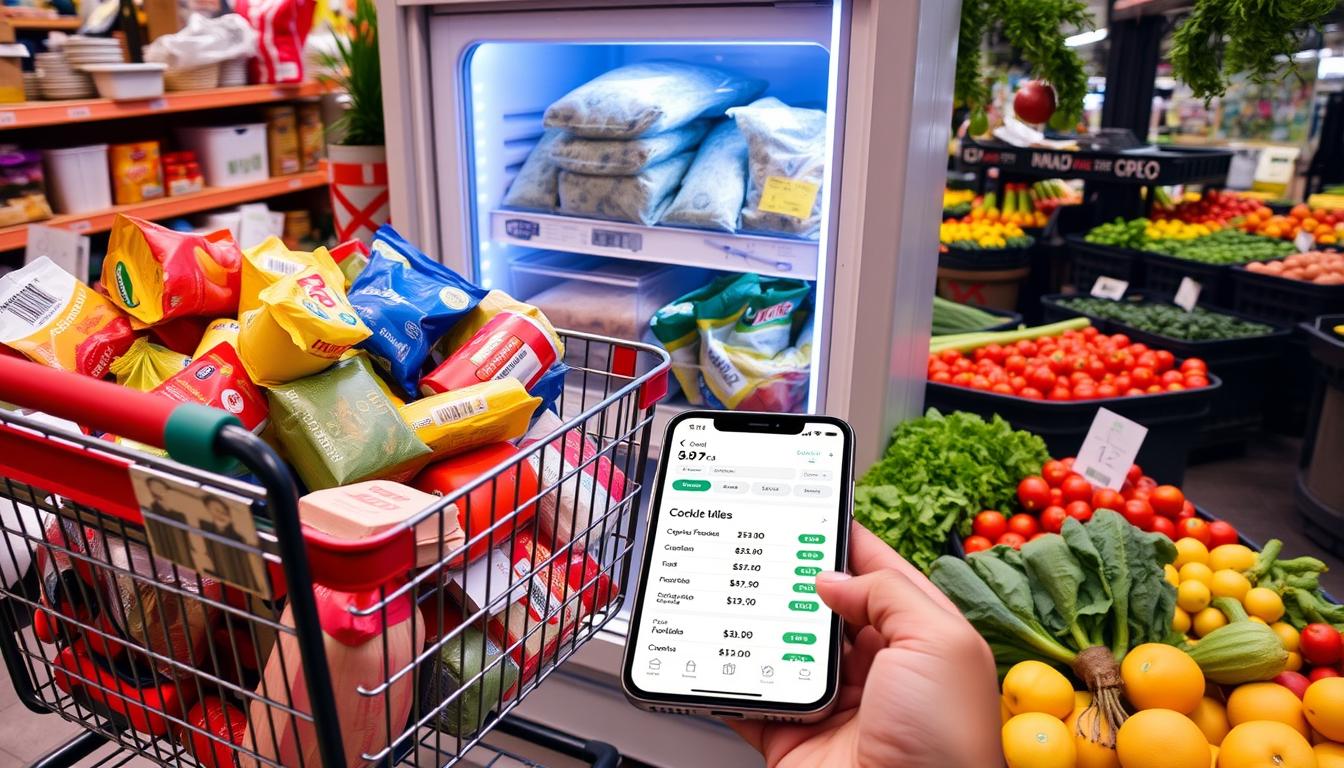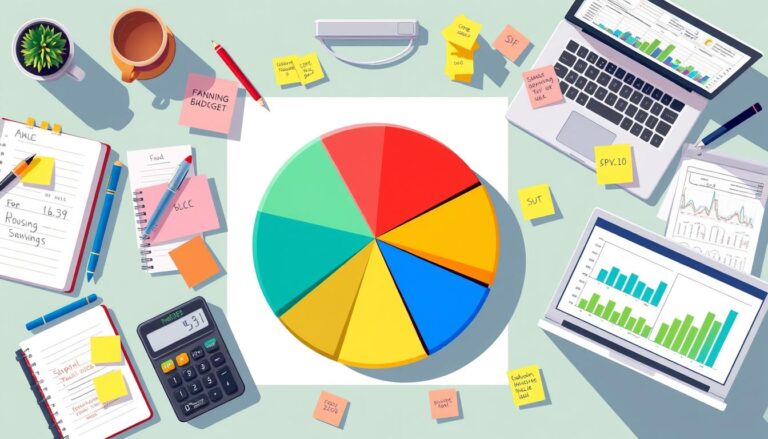How Can I Save More Money on Groceries and Bills?
Table of Contents
Understanding Current Grocery Spending Patterns
Average Monthly Grocery Expenses in America
Factors Affecting Grocery Costs
Setting Realistic Budget Goals
“Smart grocery budgeting isn’t about spending less, but spending wisely.” – Consumer Spending Expert
Smart Meal Planning Strategies for Cost Reduction
Planning your meals is an excellent way to cut down on grocery expenses. It can cut your food costs by up to 50% and reduce waste too.
“Planning your meals is like creating a financial roadmap for your kitchen” – Budget-Wise Chef
Here are some tips to make meal planning save you money:
- Create a weekly meal plan before shopping
- Use ingredients across multiple meals
- Shop with a detailed grocery list
- Embrace batch cooking
Good meal planning is all about smart thinking. Families can save about $200 a month by eating at home more. Buying things like eggs, potatoes, and rice can stretch your budget.
Here are some tips for making meals on a budget:
- Buy seasonal produce
- Use frozen vegetables (around $1.50 per pound)
- Incorporate affordable protein sources
- Repurpose leftovers creatively
Keep track of your spending and change your plan as needed. Meal planning isn’t just about saving money—it’s about making healthy, tasty meals and staying financially smart.
Save on Money Through Strategic Shopping Times
Timing is key when saving on groceries. Smart shoppers know that when you buy is as important as what you buy. By shopping strategically, you can find big discount deals and save money all year.
Buying seasonal produce can save you up to 50% on your grocery bill. This method not only saves money but also gives you the freshest ingredients.
Best Days for Grocery Shopping
Choosing the right shopping day can help you save more. Here are some times to consider:
- Midweek (Wednesday or Thursday) often has the best markdowns
- Early morning or late evening for cheaper perishables
- First and last days of sales cycles for the biggest discounts
Seasonal Shopping Benefits
Seasonal shopping can cut your grocery costs a lot. Fruits and vegetables in season can be 30-50% cheaper than those out of season.
Off-Peak Shopping Advantages
Shopping during off-peak hours has its own benefits:
- Less crowded stores
- More chances to find clearance items
- Less chance of impulse buys
- A more relaxed shopping experience
Pro tip: Grocery stores often lower prices on perishables like meat and deli items 1-2 days before they expire.
By using these smart shopping strategies, families could save about $1,500 a year on groceries.
Maximizing Store Loyalty Programs and Rewards
Bargain hunting is more than just finding discounts. It’s about using store loyalty programs to save money. The average person joins 16 loyalty programs, but many don’t use them well.
Being smart about loyalty programs can change how you shop. Studies show that members spend 60% more on a brand after joining. This can lead to big savings.
- Evaluate program benefits carefully
- Track points and rewards systematically
- Compare different loyalty programs
- Prioritize flexible redemption options
Here are some key strategies for using loyalty programs:
- Understand point accumulation rules
- Choose programs that fit your shopping habits
- Use rewards with existing discounts
- Look for bonus point offers
“A 5% increase in customer loyalty can boost profits by 25-90%” – Harvard Business Review
Returning customers spend 67% more than new ones. This makes loyalty programs crucial for saving money. By using these programs wisely, you can get great discounts and improve your bargain hunting.
Pro tip: Find loyalty programs with flexible redemption options and partnerships with other brands. This way, you can save even more.
Bulk Buying and Storage Solutions
To save money on groceries, smart shopping is key. Purchasing in bulk is an effective way to reduce expenses. It can help you save a lot on your grocery bill.
Buying in bulk can save you up to 25% on your grocery bill. Knowing which items to buy in bulk and how to store them is important. It can really help your budget.
Smart Items for Bulk Purchases
- Dry goods like rice, beans, and pasta
- Pantry staples such as flour and sugar
- Frozen vegetables and meats
- Household cleaning supplies
- Personal care products
Strategic Storage Solutions
Proper storage is key to getting the most from bulk buying. Use airtight containers and label them with the date you bought them. This helps keep track of how fresh they are.
| Item Category | Bulk Savings | Recommended Storage Method |
|---|---|---|
| Grains | 25% per pound | Sealed containers in cool, dry place |
| Frozen Meats | 20% savings | Vacuum-sealed bags in freezer |
| Cleaning Supplies | 30% discount | Original containers in dry cabinet |
Cost Analysis: Bulk vs. Regular Shopping
“Buying in bulk isn’t just about quantity; it’s a smart way to save strategically.”
While buying in bulk can save a lot, watch out for waste. Make sure you know how much your family will use before buying a lot. Not all bulk items save money, so check prices carefully.
Our research found that 65% of households save money by buying in bulk. Focus on non-perishable items and plan your shopping. This can really change your grocery budget.
Digital Tools and Apps for Grocery Savings

Today, saving money is easier than ever with digital tools. Mobile apps and online platforms can help you find big discounts. This way, you can cut down your grocery costs a lot.
Many apps are great for saving money:
- Rakuten: Gives a $10 bonus when you spend your first $25
- Honey: Automatically finds and applies checkout coupons
- Ibotta: Gives cash back when you reach $20 in receipts
- Drop: Earns reward points for major retailers
- Flipp: Compares prices in 2,000+ stores
Using apps wisely can change how you shop. Shopkick lets you earn points by scanning products in stores. RetailMeNot offers coupon codes that can cut prices by 20% or more.
| App | Key Feature | Potential Savings |
|---|---|---|
| GasBuddy | Gas price comparisons | Up to 25¢ per gallon |
| Dosh | Automatic cash-back | No manual entry required |
| Target Circle | Store-specific discounts | 5% off purchases |
“Digital tools are the modern consumer’s best friend in cutting grocery expenses.” – Savings Expert
By using these digital tools, you can save hundreds of dollars a year. Start using these apps and see your grocery budget go down!
Generic vs. Brand Name: Making Smart Choices
Shopping for groceries can be tough, especially when picking between generic and brand name items. Frugal living is about making smart choices that save money without losing quality.
Thrifty living means understanding what’s behind product labels. Brand name items usually cost 10-30% more than generics. Choosing store brands can save you up to 50%.
Quality Comparison Guidelines
Not all generic products are the same. Here are some tips for making good choices:
- Compare ingredient lists carefully
- Read nutrition labels for identical information
- Start with small purchases to test quality
- Check product reviews and recommendations
Price Difference Analysis
| Product Category | Average Generic Savings | Recommended Approach |
|---|---|---|
| Pantry Staples | 25-40% | Always choose generic |
| Cleaning Supplies | 30-50% | Safe to switch |
| Medications | 50-80% | Consult pharmacist |
| Specialty Items | 10-20% | Evaluate case by case |
Best Categories for Generic Products
Some items are great for generic versions:
- Staple foods (salt, sugar, flour)
- Basic cleaning products
- Over-the-counter medications
- Paper products
- Baking ingredients
“The smartest shoppers know that the label doesn’t always determine quality.” – Consumer Savings Expert
Embracing frugal living means being smart with your money. Start small, track your savings, and add more generics to your shopping list.
Reducing Food Waste to Save Money

Did you know the average American family tosses out about $1,500 worth of food each year? This fact shows a big chance to save money by managing food better.
Reducing food waste is not just good for the planet—it’s also a smart way to lower your grocery bills. In the U.S., up to 40% of food is wasted, costing a whopping $408 billion each year.
“Waste not, want not” has never been more relevant in today’s economic landscape.
Here are some easy ways to cut down on food waste and save money:
- Plan meals ahead to avoid buying too much
- Keep foods in the right place to last longer
- Know what date labels mean to avoid throwing things away too soon
- Freeze extra fruits and veggies
- Get creative with leftovers in new dishes
Freezing food can really help save money. Freezing extra produce can make it last up to 50% longer. Keeping your freezer at 0° F helps keep food fresh and stops it from going bad.
Meal planning is also a key strategy. It can cut your grocery costs by 20-30%. Being mindful of what you buy and eat leads to saving money and less waste.
Try these tips, and you’ll see your grocery bills go down while reducing waste. It’s a small change that can make a big difference in your wallet.
Conclusion
Starting to save money on groceries is easy with small steps. By using the tips we shared, you can change how you shop for bargains. This will help you spend less on food each month.
Smart shopping is more than just saving money. It’s about making choices that help your family’s budget. By comparing prices, buying in bulk, using loyalty programs, and wasting less food, you can save a lot. These actions help you manage your money better.
Studies show that tracking your spending and saving can cut monthly costs by up to 15%. By sticking to these shopping tips, you help reach bigger financial goals. Start with small steps, stay consistent, and see your savings grow.
Financial experts say you should save at least 20% of your income. By using the bargain hunting tips from this guide, you’re not just saving on groceries. You’re learning a way to manage your money that will benefit you for years to come.
FAQ
How much can I realistically save on my monthly grocery bill?
Are digital coupon apps really worth the time and effort?
Is buying in bulk always a good money-saving strategy?
How can I reduce food waste and save money simultaneously?
What are the best days to grocery shop for maximum savings?
Are generic brands really as good as name-brand products?
How can store loyalty programs help me save money?
What digital tools can help me save on groceries?
How important is meal planning for saving money?
What strategies work best for reducing overall grocery expenses?
Source Links
- 11 tips for saving money at the grocery store – https://www.cnbc.com/select/how-to-save-on-groceries/
- 12 Tips For Saving Money On Groceries – https://www.forbes.com/sites/enochomololu/article/how-to-save-money-on-groceries/
- How to Save Money on Groceries – https://www.ramseysolutions.com/budgeting/ways-to-save-on-groceries?srsltid=AfmBOoqtsPL8AYwBgFfd1uRBZTJhkgKsP-H1meSVk_VepiWo5hAl8PNN
- Average Cost of Groceries Per Month and How Much You Should Spend – NerdWallet – https://www.nerdwallet.com/article/finance/how-much-should-i-spend-on-groceries
- How to Save Money on Groceries – https://www.ramseysolutions.com/budgeting/ways-to-save-on-groceries?srsltid=AfmBOopn4hWlv55w29sXaI-BEeqLYGnc3i2g1k4x9_A1T7a5QYFvUgBz
- Meal Planning on a Budget & Why You’ll Love It! – Becoming Traditional – https://becomingtraditional.com/meal-planning-on-a-budget/
- Budget-Friendly Meal Planning for Families – https://jow.com/guide/category/saving-on-groceries-c-5SCg/budget-friendly-meal-planning-for-families-q-b7NRsc
- 28 Proven Ways to Save Money – NerdWallet – https://www.nerdwallet.com/article/finance/how-to-save-money
- Grocery Shopping Strategies That Save You Money – Money Digest – https://www.moneydigest.com/1634811/grocery-shopping-strategies-save-money/
- How to save money at the grocery store – https://fmtrust.bank/money-moves-article/how-to-save-money-at-the-grocery-store/
- How To Create A Loyalty Program Strategy That Maximizes Revenue | Friendbuy – https://www.friendbuy.com/blog/loyalty-program-strategy
- 5 Ideas for Your Loyalty Program – https://www.business.com/articles/5-loyalty-program-ideas/
- Saving Money with Bulk Purchases – https://angieswholesale.com/saving-money-with-bulk-purchases-tips-for-small-business-owners/
- Bundle & Save: How Buying in Bulk Can Save Your Time and Money – Healthy Blog – https://foodtolive.com/healthy-blog/bundle-save-how-buying-in-bulk-can-save-your-time-and-money/?srsltid=AfmBOooQ3NbzjtqCnRVvXRlGeZ-_baHA7R1M7DnDijRIl7j3WDhEDnYn
- 16 Best Coupon Apps of 2025 – https://www.ramseysolutions.com/budgeting/best-coupon-apps?srsltid=AfmBOoqSfupMhuyYeLUWwHlCtaDUaKvUT8dUFwxd0ANzny13wCx4H4lX
- Flipp: Shop Grocery Deals – Apps on Google Play – https://play.google.com/store/apps/details?id=com.wishabi.flipp
- How AI Can Help You Save Money on Groceries – https://www.cnet.com/tech/services-and-software/how-to-use-ai-to-save-money-on-groceries/
- What’s the difference between brand-name items and generics? – Marketplace – https://www.marketplace.org/shows/million-bazillion/whats-the-difference-between-brand-name-items-and-generics/
- Generic vs. Name Brand: A Smart Shopper’s Guide to Saving Money – Poor Man’s Guide – https://poormansguide.com/when-to-buy-generic-vs-name-brand-shopping-guide/
- How To Stop Food Waste (and save money) – https://plaineverything.com/how-to-stop-food-waste/
- Tips to Reduce Food Waste and Save Money at the Grocery Store | UNL Food – https://food.unl.edu/article/tips-reduce-food-waste-and-save-money-grocery-store/
- Simple ways to prevent food waste and save money this holiday season – https://clarkgreenneighbors.org/news-events/blog/entry/save-money-and-prevent-waste-this-holiday-season
- Why Saving Money Is Important – https://www.investopedia.com/articles/personal-finance/031215/why-saving-money-important.asp
- THE VALUE OF SAVING – Vista Bank – https://www.vistabank.com/resources/financial-literacy-resource-center/the-value-of-saving/
- Financial Confidence | Financial Control | An Post – https://www.anpost.com/Money/Managing-Finances/Blog/Global-Money-Week-Saving-vs-Spending







